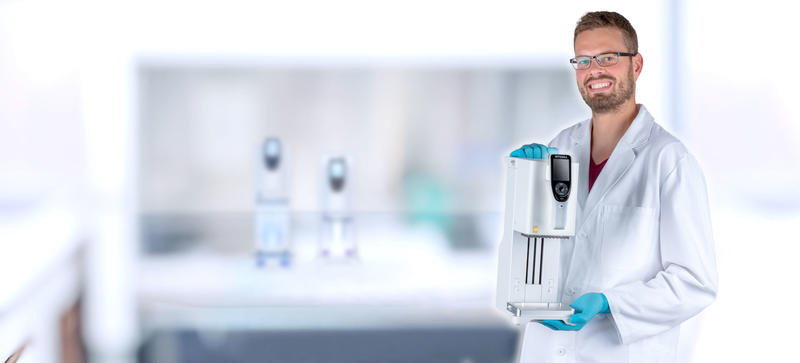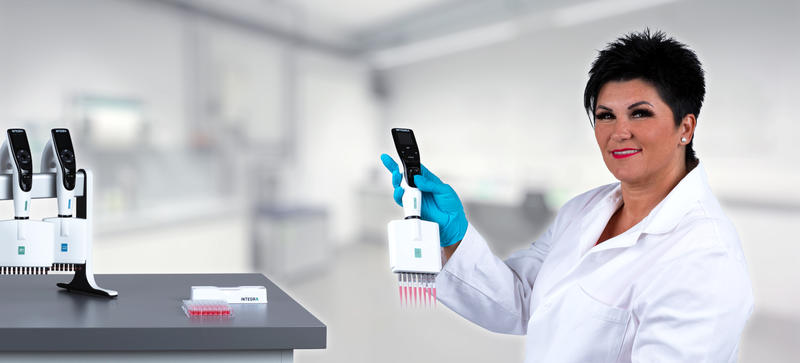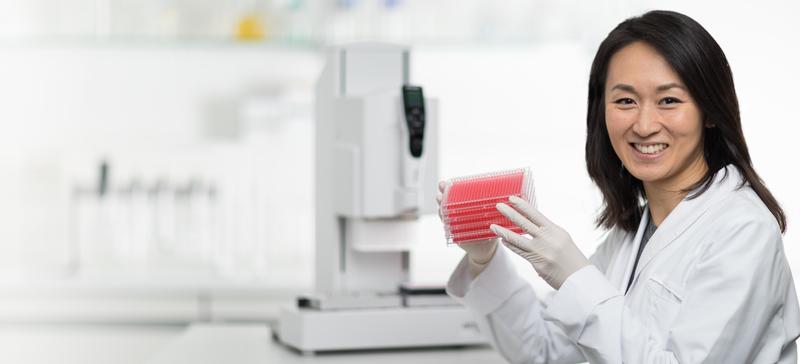-
Automated set-up of the Lonza PyroGene® Recombinant Factor C Assay Endotoxin Detection Test on the ASSIST PLUS
Automated bacterial endotoxin test
The Lonza PyroGene® Recombinant Factor C (rFC) Endotoxin Detection Assay is an alternative to the traditional limulus amebocyte lysate (LAL) assay, which is widely used to screen for bacterial endotoxin contamination in human and animal parenteral pharmaceuticals and medical devices. The rFC test is used in both high and low throughput laboratories and, unlike the LAL assay, it is not derived from horseshoe crab blood. Setting up the test requires manual preparation of 10-fold diluted standards from the endotoxin stock solution supplied. Standards and samples are added in duplicate wells to a 96 well plate. To check for product inhibition, positive product controls (PPCs), which are samples spiked with a known concentration of endotoxin, are alongside samples. Following the initial plating of the standards, samples and PPCs, a 10-minute pre-incubation is performed, during which the user prepares a working solution that consists of the fluorogenic substrate, assay buffer and rFC enzyme.
This application note demonstrates that the preparation of the standards, samples, PPC samples and blanks, and their addition to the 96 well plate, can be easily automated on the ASSIST PLUS pipetting robot using a D-ONE single channel pipetting module. Addition of the working reagent is then completed using the VOYAGER adjustable tip spacing multichannel pipette. Automation of all the pipetting steps reduces the opportunity for pipetting errors, and ensures robust reproducibility. The key quality indicators in this assay are the correlation coefficient of the standard curve and coefficient of sample variation (CV).
-
Table of contents
The Lonza PyroGene® Recombinant Factor C (rFC) Endotoxin Detection Assay is an alternative to the traditional limulus amebocyte lysate (LAL) assay, which is widely used to screen for bacterial endotoxin contamination in human and animal parenteral pharmaceuticals and medical devices. The rFC test is used in both high and low throughput laboratories and, unlike the LAL assay, it is not derived from horseshoe crab blood. Setting up the test requires manual preparation of 10-fold diluted standards from the endotoxin stock solution supplied. Standards and samples are added in duplicate wells to a 96 well plate. To check for product inhibition, positive product controls (PPCs), which are samples spiked with a known concentration of endotoxin, are alongside samples. Following the initial plating of the standards, samples and PPCs, a 10-minute pre-incubation is performed, during which the user prepares a working solution that consists of the fluorogenic substrate, assay buffer and rFC enzyme.
This application note demonstrates that the preparation of the standards, samples, PPC samples and blanks, and their addition to the 96 well plate, can be easily automated on the ASSIST PLUS pipetting robot using a D-ONE single channel pipetting module. Addition of the working reagent is then completed using the VOYAGER adjustable tip spacing multichannel pipette. Automation of all the pipetting steps reduces the opportunity for pipetting errors, and ensures robust reproducibility. The key quality indicators in this assay are the correlation coefficient of the standard curve and coefficient of sample variation (CV).
Key benefits
- Automated preparation of standard dilutions eliminates pipetting errors that would invalidate entire runs.
- Users can perform testing of full plates or partial plates by using the D-ONE single channel pipetting module in combination with the flexible and easy to program ASSIST PLUS.
- Error-free pipetting ensures replicate samples with tight CV values, reducing the likelihood of repeat testing.
- On-screen prompts guide the user through instrument set-up.
Overview: How to perform the PyroGene® rFC endotoxin detection assay
The PyroGene® Recombinant Factor C (rFC) Endotoxin Detection Assay is a fluorogenic assay that requires a fluorescence microplate reader – the PyroWave® XM Reader paired with WinKQCL® Endotoxin Detection & Analysis Software – to measure endotoxin values. Prior to setting up the plate, a template is prepared in WinKQCL® Software. Figure 1 shows the WinKQCL® Software template that was developed for use with samples plated by the ASSIST PLUS. This template allows up to 21 samples to be tested in duplicate on one plate with paired PPC samples. It is designed to provide the most flexibility for varying numbers of samples, while still allowing use of an 8 channel multichannel pipette to deliver rFC working solution to the plate, as written in the instructions for use.
Downloads: App note and protocols for automated set-up of the Lonza PyroGene® Recombinant Factor C Assay Endotoxin Detection Test on the ASSIST PLUS
The D-ONE 5-300 µl single channel pipetting module is first used to prepare standard dilutions. Following preparation of the standards, PPC is added to the designated wells of the 96 well plate in a repeat dispense mode. Next, standards and samples are added to the plate according to the above template. Standards and samples are added to the plate in duplicate, with samples added to both clean and PPC-spiked wells. Once all samples are added, the plate is pre-incubated at 37 °C for 10 minutes. During the incubation, the user prepares the working reagent in an INTEGRA 10 ml SureFlo™ reagent reservoir. At the end of the 10 minute pre-incubation, the working reagent is added to the plate using a VOYAGER 8 channel 300 µl pipette on the ASSIST PLUS.
Tips:
- Use pyrogen-free certified GRIPTIPS® in combination with SureFlo reservoirs to ensure accurate results. 10 ml SureFlo reservoirs require a dead volume of less than 30 µl.
- LONG 300 µl GRIPTIPS can access sample volumes of below 1 ml in 13 x 100 mm Lonza pyrogen‑free test tubes, and will never leak or fall off.
- PPC and samples are dispensed using repeat dispense mode to save time and money.
- Plate layout of the blank, standards and samples in the WinKQCL® Software template is designed to offer the most flexibility for running full or partial plates.
Experimental set-up:
Deck position A: LAL water – 10 ml multichannel reagent reservoir
Deck position B: PyroGene® rFC assay plate – 96 well flat bottom plate (Corning)
Deck position C: Standards, samples and PPC spike – INTEGRA tube rack
1. PyroGene® rFC assay plate set-up
Standards, samples and PPC spiked samples are added to the plate.
Pair the D-ONE 0.5-300 µl single channel pipetting module with the ASSIST PLUS pipetting robot. Place pyrogen-free test tubes containing 1 ml sample in the tube rack on deck position C (blue tubes in Figure 2). Place three empty tubes in positions A1-A3 within the rack. These are used to create the standard dilutions (magenta tubes in Figure 2). Place a tube holding 250 µl of 20 EU/ml endotoxin standard in A4 in the rack (green tube in Figure 2). Place a 10 ml SureFlo reservoir holding LAL water on deck position A, and a 96 well fluorescence plate on deck position B.
When the 'Lonza PyroGene® Assay plate set-up' program is started, the pipette first dispenses 900 µl of LAL water into each of the three empty dilution tubes (Figure 3). Next, 750 µl of LAL water is dispensed into the tube holding 250 µl of 20 EU/ml endotoxin standard, creating a 5 EU/ml standard. Following package insert instructions, a message on the pipette instructs the user to vortex the 5 EU/ml standard for 1 minute. The ASSIST PLUS pauses for the user to perform this step, then restarts when the user acknowledges the message. The next standard is created by transfer of 100 µl of the 5 EU/ml standard to the adjacent tube holding 900 µl of LAL water, followed by vortexing. The remaining two standards are similarly created.
Once all the standards are created, 10 µl of the 5 EU/ml standard is added to each well of the plate designated as a PPC (Figure 4). This serves as a control to monitor for sample inhibition of endotoxin detection. Each blank, standard and sample is then added to the appropriate wells in duplicate. Duplicate samples are also added to the PPC wells, creating the 0.5 EU/ml PPC-spiked samples. When all standards and samples have been added to the plate, the plate is pre-incubated at 37 °C for 10 minutes.
2. PyroGene® assay reagent addition
Add 100 µl working reagent to each well of the plate.
While the plate is pre-incubating, manually prepare the working reagent in a 10 ml SureFlo reservoir by combining fluorogenic substrate, rFC assay buffer and rFC enzyme solution in a 5:4:1 ratio. Place the working reagent in a clean 10 ml SureFlo reservoir on deck position A (Figure 5). Pair the 300 µl 8 channel VOYAGER pipette with the ASSIST PLUS, and exchange the D-ONE tip deck for the standard tip deck. At the end of the 10 minute pre-incubation, place the plate on deck position B. Initiate the VIALAB program 'Lonza PyroGene® Assay reagent addition' to add 100 µl reagent to each well of the plate. When reagent addition is complete, place the plate in the fluorescence microplate reader to complete the assay.
Tips:
- VIALAB programs can be adapted to accommodate different numbers of samples, giving laboratories total flexibility to meet current and future testing demands.
- LONG 300 µl GRIPTIPS are used in all steps of this assay, simplifying the purchasing process for customers.
Assay verification
Three runs of 21 samples and standards were set up on the ASSIST PLUS and tested according to the PyroGene® rFC Assay instructions for use. Samples consisted of LAL water spiked with known concentrations of endotoxin standard. 5 samples at each concentration were run on each plate, except for the 0 EU/ml sample, which was run 6 times per plate. Data analysis was performed using WinKQCL® Software. Table 1 shows the concentrations of standards and samples.
Table 1: Endotoxin concentrations of standards and spiked samples.
| Standards [EU/ml] | Samples of LAL water spiked with endotoxin [EU/ml] |
| 5 | 2.5 |
| 0.5 | 0.25 |
| 0.05 | 0.025 |
| 0.005 | 0 |
Results
Results are displayed in Tables 2-4. The standard curve for all runs displayed linearity, and all curves were within the quality parameters as defined by the instructions for use (Table 2). Samples spiked with each concentration of endotoxin were detected (Figure 6). All unspiked samples remained undetectable at <0.005 EU/ml, which is the cut-off for acceptable endotoxin concentrations in pharmaceuticals and medical devices. All replicates of standards, samples and PPC samples displayed a CV within the acceptable limit of below 25 % (Table 3).
Table 2: Standard curve results with quality specifications for runs 1-3.
|
Correlation coefficient (0.980-1.000) |
Slope (0.760-1.110) |
Y-intercept (2.500-5.000) |
|
| Run 1 | 1.000 | 0.930 | 4.112 |
| Run 2 | 0.999 | 0.903 | 4.258 |
| Run 3 | 0.998 | 0.909 | 4.267 |
Table 3: Mean coefficient of variation per plate for paired samples and PPC samples.
| Mean paired sample %CV | Mean PPC %CV | QC fail %CV per plate | |
| Run 1 | 4.19 | 4.37 | 0 |
| Run 2 | 1.84 | 4.03 | 0 |
| Run 3 | 3.66 | 3.87 | 0 |
| Overall Mean | 3.23 | 4.09 | 0 |
Remarks
- Partial plates: The supplied VIALAB programs can be adapted for partial plates, or for running samples in triplicate.
- Run report: If the ASSIST PLUS pipetting robot is connected to the PC, VIALAB programs can be started directly from the PC. After the run, a report is automatically generated, documenting details such as start and end times, user identification, calculated volumes and any errors that occurred. This offers a convenient way to fulfill regulatory requirements.
Conclusion
- The ASSIST PLUS provides an affordable, easy-to-use automation solution for low to medium throughput users of the Lonza PyroGene® rFC Endotoxin Detection Assay.
- High quality, reproducible results can be achieved with the ASSIST PLUS, eliminating the risk of costly and time-consuming retests.
- The ease and flexibility of VIALAB software allows users to customize plate layouts or set up partial plates using the same labware defined in this application note.
Ask our expert. Leave a comment!
Write us if you have any questions regarding the application note or one of our instruments.
Any questions? I'm happy to help!
Instruments and accessories
ASSIST PLUS, Pipetting Robot
INTEGRA has developed the ASSIST PLUS pipetting robot to streamline routine pipetting tasks at an affordable price. Using INTEGRA electronic multichannel pipettes, the system:
- automates pipetting tasks,
- eliminates physical strain and
- ensures superior reproducibility and
- error free pipetting.
Part No. 4505
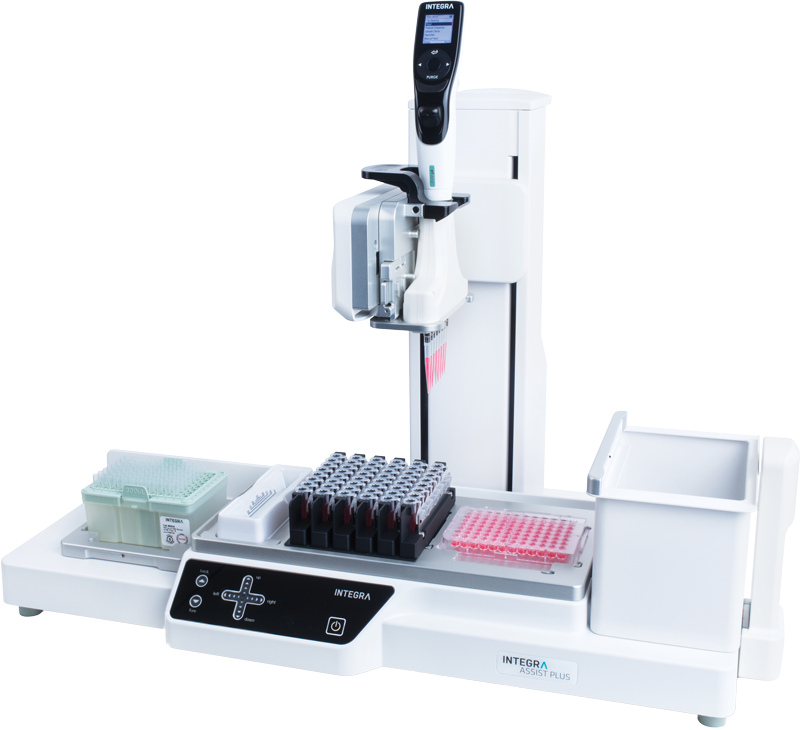
D-ONE Single Channel Pipetting Module, 0.5-300 µl
The D-ONE single channel pipetting module offers hands-free transfers from individual tubes or wells on the ASSIST PLUS pipetting robot. This makes it the perfect add-on for labs that want to go beyond the possibilities of multichannel pipetting to access unlimited applications. It is designed to offer easy automation of normalization, hit picking and master mix preparation, freeing up your time while eliminating transcription errors.
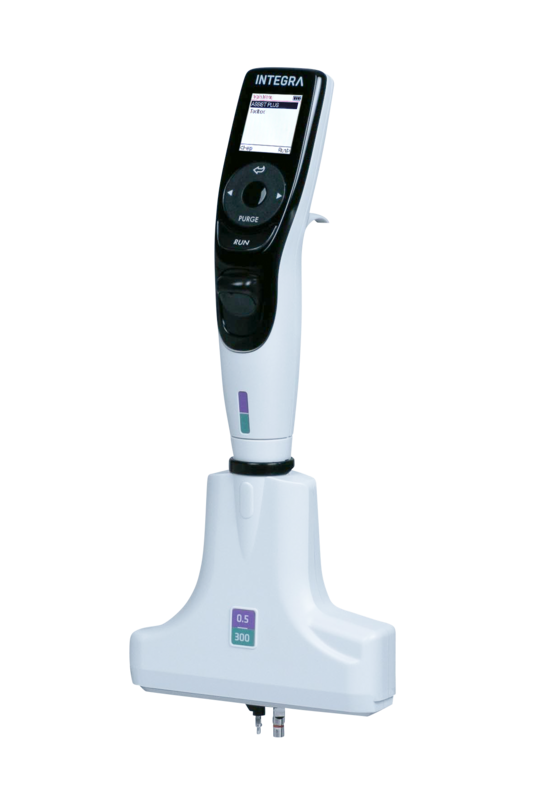
VOYAGER, 8 Channel, 300 µl
VOYAGER pipettes allow the tip spacing to expand anywhere between 4.5 mm and 33 mm at the push of a button.
- Single handed operation leaves the other hand free to handle labware.
- On the fly access to up to 3 user-defined tip spacings.
- These user defined tip spacings are saved. No need to memorize spacings of different labware formats.
Part No. 4723
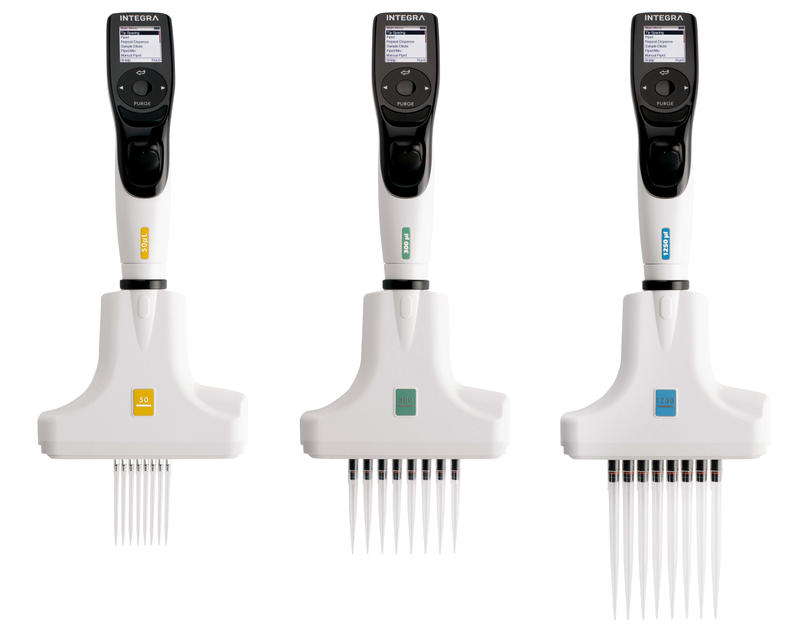
Tip deck for D-ONE on ASSIST PLUS
- Supports accommodation of 1 x 12.5 µl/ 125 µl tip box and 1 x 300 µl/ 1250 µl tip box
- Compatible with D-ONE Pipetting Module 0.5 - 300 µl and 5 - 1250 µl
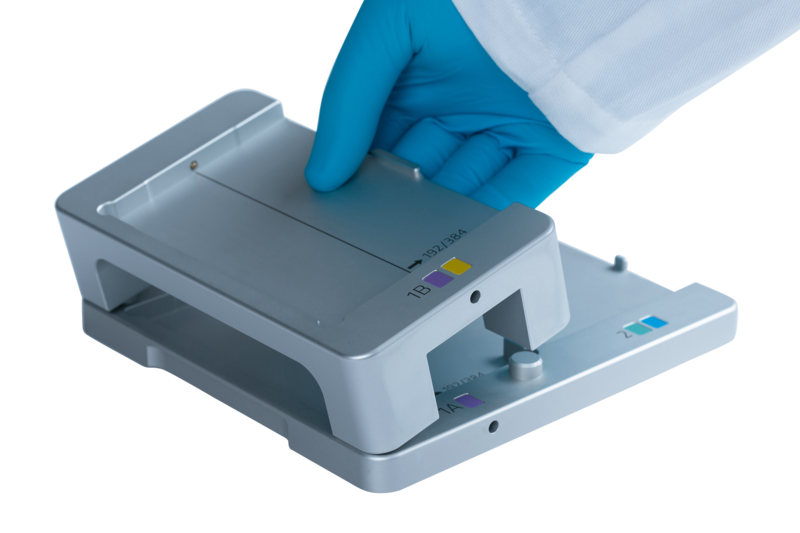
GRIPTIPS®, 300 µl LONG, Sterile
Precise and consistent tip seal ensures that all tips on a MINI 96, VIAFLO 96 and VIAFLO 384 are at an identical height for reliable touch offs and consistent pipetting results. An additional tip straightness inspection process ensures all pipette tips access wells even when dispensing to a 384 well plate.
Part No. 6484
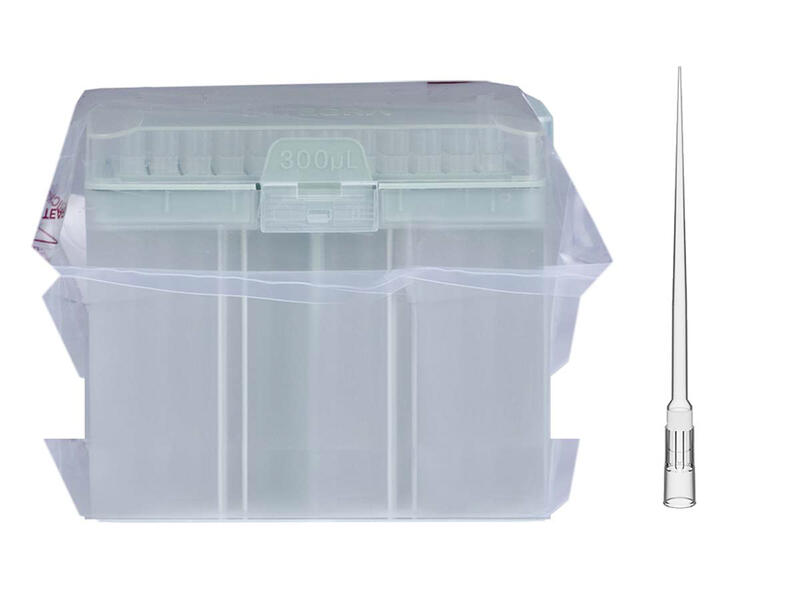
Multichannel Reagent Reservoir, 10 ml, PS
- SureFlo™ anti-sealing array prevents pipette tip seal off which can cause liquid to pop into the tip, filter or even the pipette itself
- Unique surface treatment spreads liquid evenly offering even lower dead volumes
- Reusable base with bold, crisp, clearly visible graduation markings
- Nest inside each other, making it possible to get twice as many reservoirs in half the space of other products on the market
- Reducing inventory space requirements and shipping costs
- Available as crystal clear polystyrene reservoirs or polypropylene reservoirs for improved chemical compatibility
Part No. 4371
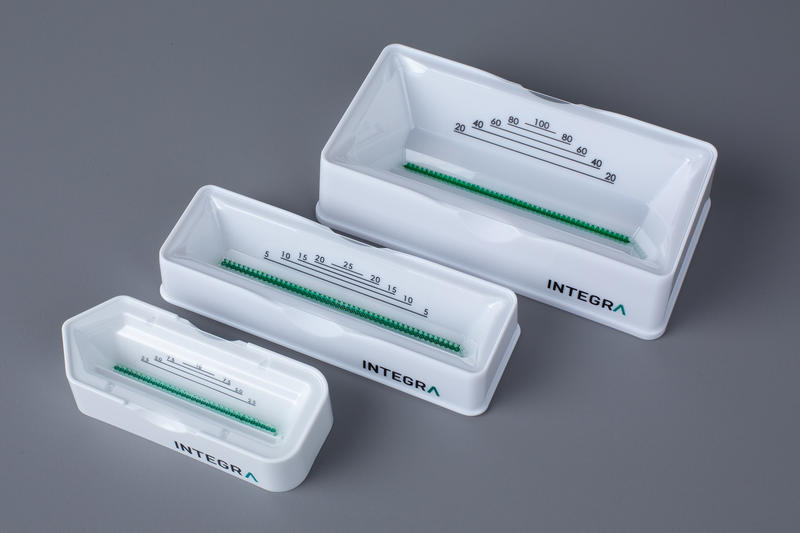
Disposable Reservoirs, 10 ml, Sterile, SureFlo™ anti-sealing array, PS
SureFlo™ anti-sealing array prevents pipette tip seal off which can cause liquid to pop into the tip, filter or even the pipette itself.
Part No. 4371

6 x 8 Tube Rack
Rack for blood tubes (4 ml), 6x8 tubes
Part No. 4552
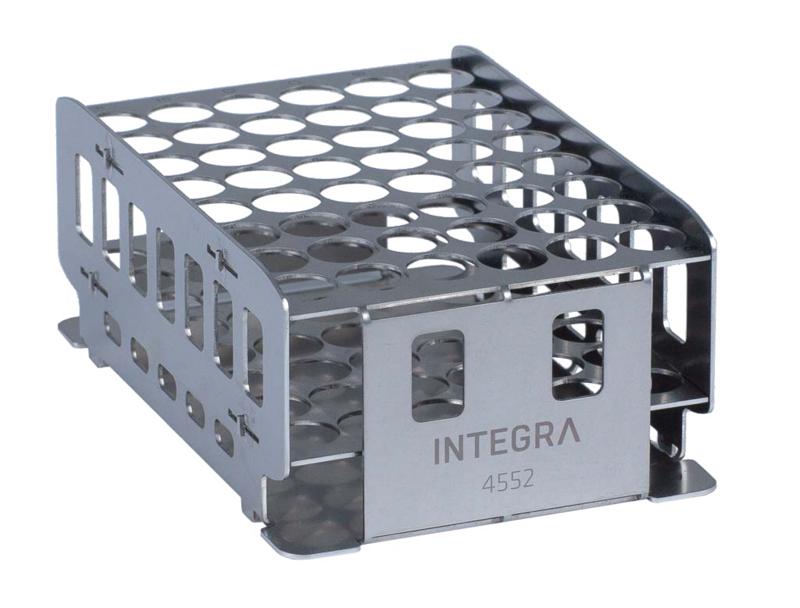
Lonza: PyroGene Recombinant Factor C Endotoxin Detection Assay
The PyroGeneTM Recombinant Factor C Assay is the evolution of endotoxin detection testing. Lonza scientists have developed a recombinant form of Factor C, the first component in the horseshoe crab clotting cascade activated by endotoxin. Recombinant Factor C (rFC) is activated by endotoxin binding, and the active enzyme then cleaves a synthetic substrate, resulting in the generation of a fluorogenic compound. PyroGeneTM rFC works through a single enzymatic step compared to the multiple step enzymatic process necessary for LAL assays.
Source: Website Lonza
Lonza: PyroWave XM Fluorescence Reader
The PyroWaveTM XM Fluorescence Reader brings a new generation in fluorescence technology to users of the PyroGeneTM Recombinant Factor C Endotoxin Detection Assay. This fluorescence microplate reader is optimized for Lonza’s PyroGeneTM Assay, bringing new and improved technology to the laboratory.
Source: Website Lonza
Lonza: WinKQCL Software
The PyroWaveTM XM Fluorescence Reader brings a new generation in fluorescence technology to users of the PyroGeneTM Recombinant Factor C Endotoxin Detection Assay. This fluorescence microplate reader is optimized for Lonza’s PyroGeneTM Assay, bringing new and improved technology to the laboratory.
Source: Website Lonza
Lonza: Pyrogen-free Test Tubes
Pyrogen-free borosilicate glass Dilution Tubes, 13x100mm, without cap 30/pkg. All test tubes are made from USP Type 1 flint borosilicate glass. Contain less than 0.005 EU/ml endotoxin. Product number N207 is recommended for dilution of endotoxin standards and test samples for all endotoxin detection assays. Product numbers N201 and N205 are recommended for use as reaction tubes in gel clot assays.
Source: Website Lonza
Lonza: LAL Reagent Water
Lonza's LAL Reagent Water (LRW) is manufactured at theWalkersville, MD, USA facility and is tested to purity requirements beyond thatof Water for Injection (WFI) and most other non-pyrogenic water products.
Source: Website Lonza
Corning: 96 well black polystyrene microplate
- Bottoms are 60% thinner than conventional polystyrene plates, resulting in lower background fluorescence and enabling readings down to 340nm
- Opaque walls to prevent well-to-well crosstalk
- Optically clear flat well bottom permits direct microscopic viewing
- Can be used for both top and bottom reading instruments
- Flat bottoms with 360 µL total volume
- Recommended working volumes of 75 to 200 µL
- Nonreversable lids with condensation rings to reduce contamination
- Sterilized by gamma radiation and nonpyrogenic
- Individually Wrapped
Source: Website Corning
IKA: Vortex 2
New vortex shaker suitable for touch operation or continuous operation
- Touch function
- Suitable for continuous operation (low heat due to ventilation of motor)
- Stable operation at high speeds due to silicon base feet
- Infinitely adjustable speed range
- Various applications possible because of 3 interchangeable attachments and 7 inserts (e.g. Eppendorf tubes, microtiter plates, Erlenmeyer flasks 250 ml etc.), these need to be ordered separately
- Attachments securely click onto appliance in any position
- Special strap (VG 3.36) ensures easy handling of round/Erlenmeyer flasks
- Sturdy metal die cast housing
Source: Website IKA
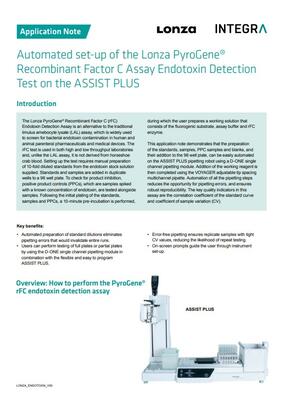
Download
Download App Note as PDF
DownloadAutomated set-up of the Lonza PyroGene® Recombinant Factor C Assay Endotoxin Detection Test on the ASSIST PLUSCustomer’s voice
We love our ASSIST PLUS because it is easy to use, easy to program, speeds up production, and helps to prevent human error and fatigue due to repetitive pipetting.

